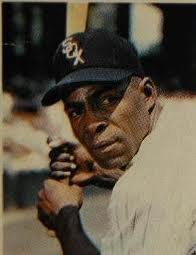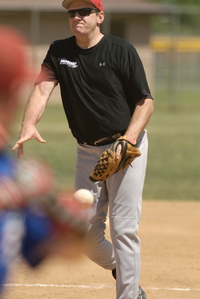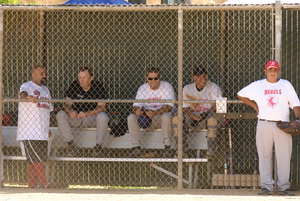KEISSER: Savala on deck for LB Hall induction
From the Long Beach Press Telegram
By Bob Keisser, Sports Columnist
The heyday of fastpitch men’s softball in Southern California passed long enough ago that most people can’t remember its demise, much less its history.
The game thrived longer in Long Beach than other communities, too, thanks to the Long Beach Nitehawks, Lakewood Jets and Long Beach Painters.
But the sport will have its day on Sept. 18 when the softball branch of the city’s Hall of Fame inducts five new members, including three men who are proof that the sport still has a profile in town.
Hice Stiles, a 2001 inductee into the International Softball Congress Hall of Fame, will be inducted – and Stiles can still be found playing the game today in masters leagues.
Darrell Kam, who played for the Nitehawks and only retired from active play a few years ago, will join Stiles, as will Al Savala – the player/coach of the vibrant Long Beach Painters who were the last local team to play high-end softball at Joe Rodgers Field, and the last local team to reach the ISC World Series (1998).
How vibrant are the Painters? Savala still fields three teams, two of them in the masters divisions (45-and-older and 50-and-older).
Their moment in the spotlight will come at the same time that the softball park gets a name change. It now will be named Red Meairs Field at Joe Rodgers Stadium, in honor of the late Meairs, the longtime Nitehawk who succeeded Rodgers as manager and kept the team on the field until financial issues and the changing times led to its closure in 1988.
Savala, on the other hand, never stopped even as the sport’s ranks were thinning. He’s the beacon of the sport, which he’s been involved with for 50 years.
His Long Beach Painters reached the ISC world tournament in four of five years between 1993 and 1998, finishing fifth in 1994 while earning the ISC Sportsmanship Award. The 2009 Long Beach Painters won the American Softball Association’s 45-and-over title.
“We’ve probably qualified for more than 100 national tournaments over the years and won 18 or so different titles,” Savala said. “We traveled a lot, too. I always thought that was the best part of the game, challenging teams from other parts of California and other states.
“When the Nitehawks and other teams stopped, we just kept going.”
Savala talked with Meairs about co-sponsoring the Nitehawks when the team was facing financial hardships, but Meairs wanted to homestand and bring teams to Rodgers Field before competing for a spot in the worlds.
Savala wanted to travel.
“I wanted exposure for the team,” he said. “I think some of the teams I had (in the ’90s) were as good as some of the championship Nitehawk teams.
“It’s worked pretty well for me. I’m pretty well known around the country for playing teams in tournaments, and it’s been fun now to go to nationals and see guys I played against. Now many of their kids are playing.”
Savala, who grew up in Northern California and started playing softball when he was 15, got his start at a high level when he was 16.
“The Knights of Columbus team lost its pitcher and my uncle asked me to teach him how to pitch,” he said, “I showed him, and he said, `heck, why don’t you pitch for us? You’re better than anyone we have.”‘
He played for several teams in the Western Softball Congress before launching the Painters. The name of his team has a story of its own.
Al Savala has been a painting contractor almost as long as he’s been playing softball. He started in high school and launched his own company in his 20s.
He’s left a literal mark on several local fields. Years ago, he noticed Lakewood’s softball fields were “starting to look a little raggedy,” so he told the city he’d paint them for free if they supplied the materials.
He would eventually paint Lakewood’s baseball fields, too … and Poly’s field when Bill Powell was coach … and the field at Cal State Los Angeles when he was asked by old friend and then Golden Eagles coach John Herbold.
“I just enjoy doing it and helping when I can. There’s no rhyme or reason for it. I just enjoy it,” he said.
His commitment to softball – he’s sponsored boys and girls softball youth teams and donated to the softball programs at Long Beach City College and Long Beach State – and well-kept fields isn’t his only contribution to Long Beach.
He was a Little League and Pony League coach in Lakewood and saw more than 30 of his former players reach the pro ranks. He’s often been invited to sit on the bench by Lancers coach Spud O’Neill since Savala knew so many of the kids.
When an illness left Lakewood High shorthanded on the soccer field, he filled in as coach, a stint that lasted six years. When then-Long Beach City College coach Larry Reisbig needed a tutor for a kicker, he asked Savala for help, and he would spend 19 years as a specialist coach for the Vikings.
The Century Club’s award for the high school athletes of the year is sponsored and named after Savala.
Savala said Stiles had – and still has – one of the smoothest swings of any player he’s ever met. Kam played for the Nitehawks and Painters, and the late Meairs said Kam was one of the grittiest, unsung players he ever had with the Nitehawks.
Induction day will revive the sport, however momentary.
“I still haven’t gotten to the point where I know what to say about this,” Savala said. “It’s nice that someone thought of me. But it’s not like I’m going away.”
Savala said he’ll coach and lead the Painters until someone pries the bat, or paint brush, out of his hand.
bob.keisser (at) presstelegram.com
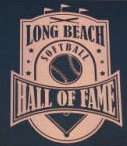
Editor’s note: I had the chance to attend a couple of the Long Beach Softball and Baseball Hall of Fame luncheons at Blair Field in Long Beach.
Here is the “Wall of Fame” at Joe Rodgers Field in Long Beach from that inaugural class of 2004:
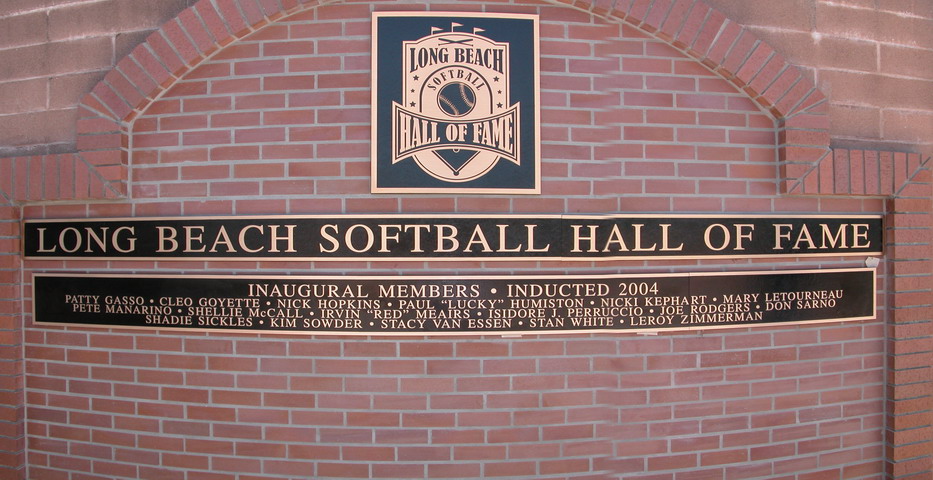
(click photo to enlarge)




